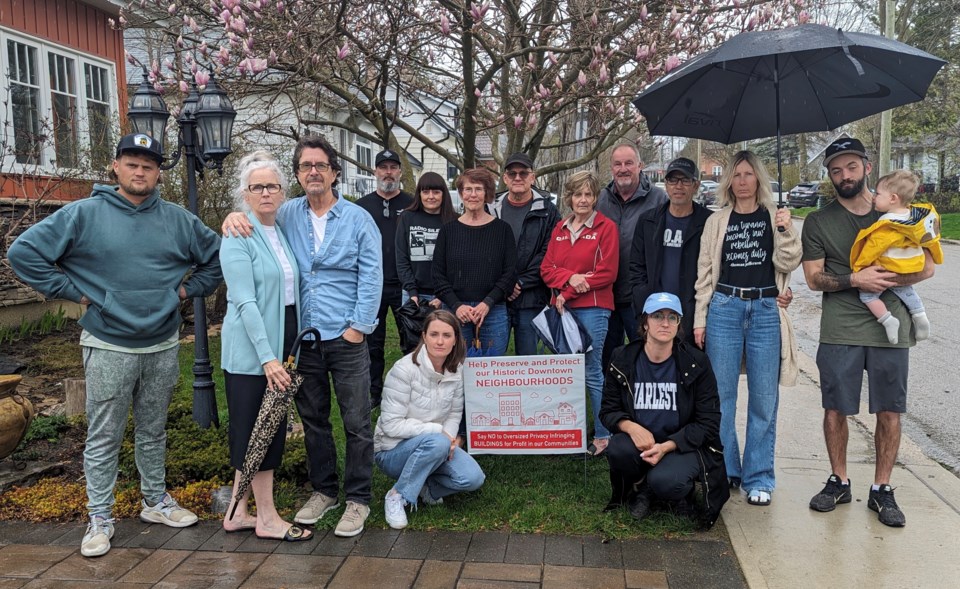Minor variances could lead to major change in a Barrie neighbourhood, residents say.
That unwanted shift would be construction of a three-storey, 10-unit walk-up apartment building at 145 Clapperton St.
While this property is zoned residential multiple dwelling second density (RM2), the city’s committee of adjustment approved minor variances April 23 to Barrie’s zoning bylaw to exceed the building’s maximum density and gross floor area allowed, while reducing the parking spaces, as well as the internal private roadway width, lot frontage, front-yard setback, landscaped open space and landscape buffer width.
“The fact that the committee dismissed 99 per cent citizen opposition in favour of outside predatory investors shows that the voice of the people simply does not matter,” said Eva Meyer, who lives on Clapperton Street. “It does not seem that committee of adjustment has prioritized the people in their decision.
“It is no surprise that community engagement and voter turnout is so poor, and public trust in all levels of government is dismal," she added.
“I feel a great sense of betrayal,” said Linda Joy, who also lives on Clapperton. “What happened to prioritizing people?”
Samantha Goddard, who lives on Clapperton Street, says the view from her front living room window will be ruined with this project.
“Our direct view will now be of this 10-unit apartment,” she said. “We understand the property is zoned RM2, however just because they can build something by law … how could you (the committee) let this application go through?
“Why did you accept all variance requests instead of asking for them to provide even less?”
The minor variances application came from Corbett Land Strategies, a Burlington company, on behalf of Jimmy La.
Corbett Land Strategies could not be reached for comment by BarrieToday.
But there’s little help available for what’s called The Grove, a historic neighbourhood.
“I understand completely why neighbouring residents are not happy with the decision, however there is little that the ward councillor can do to influence or overturn their (the committee’s) decisions,” said Coun. Craig Nixon, who represents this area.
“The committee of adjustment does not take direction from councillors and is chosen for their knowledge of existing building codes and the Official Plan, and their decisions to allow or decline any minor variances is final," the councillor added.
“Shame on me for believing in due process and that our government would make the right decision by listening to the people; in this case, 99 per cent opposed and yet the one per cent wins,” Meyer said.
She said there was a short time frame to canvass the neighbourhood, yet 70 signatures in opposition were gathered from two streets, a small fraction of the community.
“Since then, we have rallied and garnered even more support,” Meyer said. “In fact, we had made up our own lawn signs to draw public awareness to this proposed travesty. What is the purpose of having zoning bylaws when the integrity of those bylaws is so flippantly dismissed?”
Lawn signs line both sides of Clapperton, a city street of mostly single-family homes.
Goddard says three storeys and 10 units are out of step with the neighbourhood, what she calls an area with “our small scale residential streets.”
“If I wanted to be near apartment buildings,” she said, “I would have purchased near one.”
The committee of adjustment’s April 23 decision granted the variances with conditions that included obtaining demolition permits for the existing single-detached residence and accessory garage, that the variances be included in the site plan and comply with the city’s zoning bylaw, no building, servicing and grading is permitted within the canopy limits of boundary trees or those on private property without written authorization from the adjacent landowners, and where trees located on adjacent land may be negatively impacted, damaged or harmed, it is the sole liability of the developer.
The developer must also contact city planning staff to investigate the feasibility of providing a minimum of one affordable housing unit in this project, as defined in Barrie’s Official Plan.
Michelle Banfield, the city’s executive director of development services, said the committee of adjustment members are not available to speak about the decisions made by the committee, and it relies on the staff report for information, the submission materials from the applicant and the comments from members of the public.
The committee makes decisions on minor variances to the existing zoning bylaw, subject to criteria in the Planning Act.
There are four tests that must be met for a minor variance to be approved: does the application meet the general intent of the Official Plan, does the application meet the general intent of the zoning bylaw, is the variance minor in nature and is the variance appropriate for the use and development of the property.
All four tests must be met for the minor variance to be approved and any application that is approved by the committee of adjustment must satisfy the four tests.
Third-party appeals are not permitted and Barrie city council is not able to overturn a decision from committee of adjustment, Banfield said.
